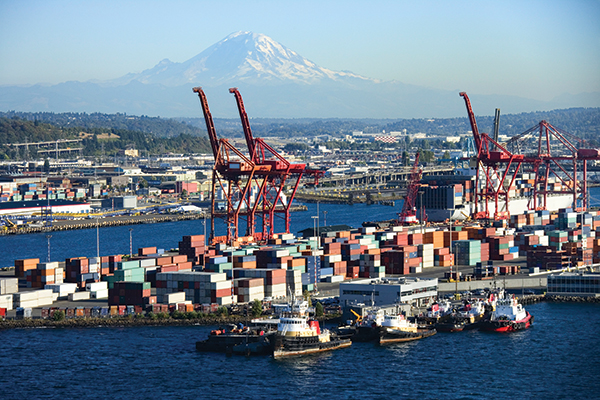As parts of the country dry up and others experience unprecedented flooding, and as the oceans flirt with an unknown transition, water is increasingly acknowledged as a precious resource best not trifled with. That reality forms the basis of the “water economy,” the idea that a region blessed with ample water might leverage it more collaboratively, productively and sustainably.
With its abundant Pacific Coast ports that open to growing markets in Asia, and with the “ocean economy” expected to double by 2030 to $3 trillion, Washington State is well-positioned to grab its share of the spoils. And perhaps more so than competing coastal states, its leadership is laying the groundwork to make that happen innovatively, equitably and with the environment first in mind.
Gov. Jay Inslee’s Washington Maritime Blue 2050 is the nation’s first statewide blueprint for a Blue Economy. A thick compendium of collaborative strategies and proposed initiatives, Maritime Blue 2050 resulted from months of investigation across government, industry, academia, environmental organizations, tribes and labor. It is a truly bold step toward the tech-based, sustainable, maritime future that awaits.
“The Washington Maritime Blue 2050 vision for accelerating innovation projects,” said Inslee, “will develop a diverse workforce, stronger businesses and new technology to meet the challenges ahead. Our goal is to build a green, efficient and sustainable maritime sector that will serve as a model for the rest of the country.”
Collaboration Is Key
Look around and maybe you’ll notice that water can be a deeply parochial resource, a fact that has served to stunt the development of regional water economies. For that reason alone, the early progress of Washington State’s initiative stands out. Maritime Blue, the newly-launched, statewide coalition whose leadership is tasked with implementing the Blue Strategy, boasts more than 120 members across the public and private sectors and academia. The idea, put simply, is to get people talking. So says Jennifer States, Maritime Blue’s VP of Projects & Strategy.
“We all have our cylinders of excellence that we don’t want to break out of,” says States. “So, we help create the plumbing between them in order to help then work more collaboratively. It’s creating that ecosystem of bringing different players together across the different organizational types.
“One of the most interesting things,” States reveals, “has been getting different sectors together. Like the utility or energy sector talking with the maritime sector about electrification. It’s bringing together doers across different sectors. They come together, and it’s sort of like lightning just strikes.”
The “fast foil ferry” is among the most highly-touted collaborative projects in Maritime Blue’s expanding universe. Kitsap Transit, a prominent Maritime Blue stakeholder, is leading a public-private partnership among regional companies, municipal agencies and nonprofits to develop a high-speed passenger ferry powered by battery-electric, low-emission technology.
Supported by the local ports of Bellingham, Skagit County and Anacortes, the project also has received a grant of $372,910 from the Federal Transportation Administration. The hydrofoil design will rely on lightweight carbon fiber construction being developed by Seattle-based Glosten and Anacortes-based Bieker Boats. That alone means jobs, but on an even higher level, the ripples from the project could prove to be transformational.
“The overall vision,” says States, “is to bring back the Mosquito Fleet to Washington State.
In the 1800s there were hundreds of ferries operating in Puget Sound, and we want to bring them back using zero-emission transportation and get more cars off the road.”

